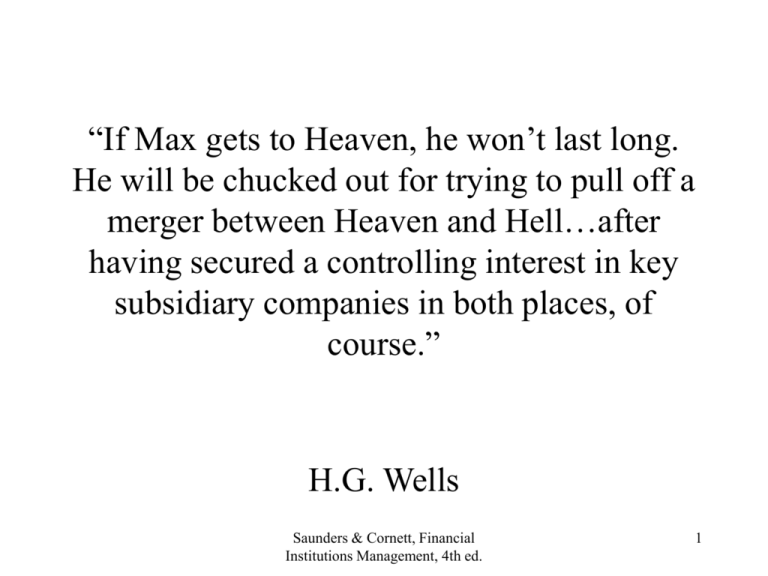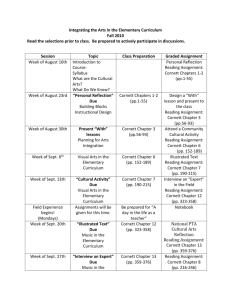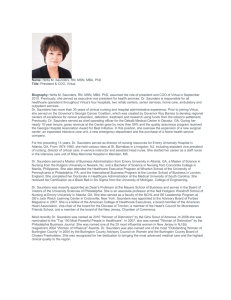Chapter 8 & 9
advertisement

“If Max gets to Heaven, he won’t last long. He will be chucked out for trying to pull off a merger between Heaven and Hell…after having secured a controlling interest in key subsidiary companies in both places, of course.” H.G. Wells Saunders & Cornett, Financial Institutions Management, 4th ed. 1 The Impact of Unanticipated Changes in Interest Rates: • On Profitability – Net Interest Income (NII) = Interest Income minus Interest Expense – Interest rate risk of NII is measured by the repricing model. (chap. 8) • On Market Value of Equity – Market Value of Equity = Market Value of Assets minus Market Value of Debt – Interest rate risk of equity MV is measured by the duration model. (chap. 9) Saunders & Cornett, Financial Institutions Management, 4th ed. 2 The Repricing Model • Rate Sensitive Assets (Liabilities) RSA/RSL: are repriced within a period of time called a maturity bucket. – Repricing occurs whenever either maturity or a roll date is reached. – The roll date is the reset date specified in floating rate instruments that determines the new market benchmark rate used to set cash flows (eg., coupon payments). • The Federal Reserve set the following 6 maturity buckets: 1 day; 1day-3 months; 3-6 months; 6-12 months; 1-5 yrs; > 5 yrs. Saunders & Cornett, Financial Institutions Management, 4th ed. 3 The Repricing Model • Repricing Gap (GAP) = RSA – RSL • R = interest rate shock • NII = GAP x R for each maturity bucket i • Cumulative Gap (CGAP) = i GAPi • NII = CGAP x Ri where Ri is the average interest rate change on RSA & RSL • Gap Ratio = CGAP/Assets Saunders & Cornett, Financial Institutions Management, 4th ed. 4 Example of Repricing Model Assets Short term (1 yr fixed rate) consumer loans Long term (2 yrs fixed rate) consumer loans 3 mo. T-bills 6 mo. T-bills 3 yr. T-bonds 10 yr, fixed rate mortgages 30 yr. floating rate mortgages (9 mo. adjustment period) TOTAL $m 50 Liabilities & Net Worth Equity Capital (fixed) $m 20 25 Demand Deposits 40 30 35 70 20 40 Passbook savings 3 mo. CDs 3 mo. bankers acceptances 6 mo. commercial paper 1 yr. time deposits 2 yr. time deposits TOTAL 30 40 20 60 20 40 270 270 Saunders & Cornett, Financial Institutions Management, 4th ed. 5 Repricing Ex. (cont.) • • • • • • • • • • 1 day GAP = 0 – 0 = 0 (DD & passbook excluded) (1day-3mo] GAP = 30 – (40+20) = -$30m (3mo-6mo] GAP = 35 – 60 = -$25m (6mo-12mo] GAP = (50+40) - 20 = $70m (1yr-5yr] GAP = (25+70) – 40 = $55m >5 yr GAP = 20 – (20+40+30) = -$70m 1 yr CGAP = 0-30-25+70 = $15m 1 yr Gap Ratio = 15/270 = 5.6% 5 yr CGAP = 0-30-25+70+55 = $70m 5 yr Gap Ratio = 70/270 = 25.9% Saunders & Cornett, Financial Institutions Management, 4th ed. 6 Assume an across the board 1% increase in interest rates • • • • • • • • 1 day NII = 0(.01) = 0 (1day-3mo] NII = -$30m(.01) = -$300,000 (3mo-6mo] NII = -$25m(.01) = -$250,000 (6mo-12mo] NII = $70m(.01) = $700,000 (1yr-5yr] NII = $55m(.01) = $550,000 >5 yr GAP = -$70m(.01) = -$700,000 1 yr CNII = $15m(.01) = $150,000 5yr CNII = $70m(.01) = $700,000 Saunders & Cornett, Financial Institutions Management, 4th ed. 7 Unequal Shifts in Interest Rates • NII = (RSA x RRSA) – (RSL x RRSL) • Even if GAP=0 (RSA=RSL) unequal shifts in interest rates can cause NII. • Must compare relative size of RSA and RSL (GAPs) to relative size of interest rate shocks (RRSA- RRSL = spread). • The spread can be positive or negative = Basis Risk. Saunders & Cornett, Financial Institutions Management, 4th ed. 8 Strengths of Repricing Model • Simplicity • Low data input requirements • Used by smaller banks to get an estimate of cash flow effects of interest rate shocks. Saunders & Cornett, Financial Institutions Management, 4th ed. 9 Weaknesses of the Repricing Model • Ignores market value effects. • Overaggregation within maturity buckets • Runoffs – even fixed rate instruments pay off principal and interest cash flows which must be reinvested at market rates. Must estimate cash flows received or paid out during the maturity bucket period. But assumes that runoffs are independent of the level of interest rates. Not true for mortgage prepayments. • Ignores cash flows from off-balance sheet items. Usually are marked to market. Saunders & Cornett, Financial Institutions Management, 4th ed. 10 Measuring the Impact of Unanticipated Interest Rate Shocks on Market Values • E = A - L • What determines price sensitivity to changes in interest rates? • The longer the time to maturity, the greater the price impact of any given interest rate shock. • This can be viewed in the positively sloped yield curve. See Appendix 8A. • But, yield curves must be drawn using pure discount yields. • The correct statement is: The longer the DURATION, the greater the price impact of any given interest rate shock. Saunders & Cornett, Financial Institutions Management, 4th ed. 11 What is Duration? • Duration is the weighted-average time to maturity on an investment. • Duration is the investment’s interest elasticity measures the change in price for any given change in interest rates. • Duration (D) equals time to maturity (M) for pure discount instruments only. • Duration of Floating Rate Instrument = time to first roll date. • For all other instruments, D < M • Duration decreases as: – Coupon payments increase – Time to maturity decreases – Yields increase. Saunders & Cornett, Financial Institutions Management, 4th ed. 12 The Spreadsheet Method of Calculating Duration Ex. 1:5 yr. 10% p.a. coupon par value s Cs 1 2 3 4 5 y 100 100 100 100 1100 0.1 0.1 0.1 0.1 0.1 Price= PV(Cs) 90.90909 82.64463 75.13148 68.30135 683.0135 1000 Duration Saunders & Cornett, Financial Institutions Management, 4th ed. tPV(Cs) 90.90909 165.2893 225.3944 273.2054 3415.067 4169.865 4.169865 13 Ex. 2: Interest Rates Decrease to 9% p.a. s Cs 1 2 3 4 5 y 100 100 100 100 1100 0.09 0.09 0.09 0.09 0.09 Price= PV(Cs) 91.74312 84.168 77.21835 70.84252 714.9245 1038.897 Duration Saunders & Cornett, Financial Institutions Management, 4th ed. tPV(Cs) 91.74312 168.336 231.655 283.3701 3574.623 4349.727 4.186872 14 Ex. 3: Interest Rates Increase to 11% p.a. s Cs 1 2 3 4 5 y 100 100 100 100 1100 0.11 0.11 0.11 0.11 0.11 Price= PV(Cs) 90.09009 81.16224 73.11914 65.8731 652.7965 963.041 Duration Saunders & Cornett, Financial Institutions Management, 4th ed. tPV(Cs) 90.09009 162.3245 219.3574 263.4924 3263.982 3999.247 4.152727 15 The Duration Model • Modified Duration = MD = D/(1+R) • Price sensitivity (interest elasticity): P -D(P)R/(1+R) • Consider a 1% increase in interest rates: • Ex. 1: P -(4.17)(1000)(.01)/1.10 = -$37.91 - New Price = 1000 - 37.91 = $962.09 Exact $963.04 • Ex. 2: P -(4.19)(1038.897)(.01)/1.09 = -$39.94 – New Price = 1038.897 – 39.94 = $998.96 Exact $1000 • Ex. 3: P -(4.15)(963.041)(.01)/1.11 = -$36.01 – New Price = 963.041 – 36.01 = $927.03 Exact $927.90 Saunders & Cornett, Financial Institutions Management, 4th ed. 16 The Duration Model: Using Duration to Measure the FI’s Interest Rate Risk Exposure • • • • • • • E = A - L A = -(DAA)RA/(1+RA) L = -(DLL)RL/(1+RL) Assume that RA/(1+RA) = RL/(1+RL) E/A -DG(R)/(1+R) where DG = DA – (L/A)DL DA = i=A wiDi DL = j=L wjDj Saunders & Cornett, Financial Institutions Management, 4th ed. 17 Consider a 2% increase in all interest rates (ie, R/(1+R) = .02) • • • • • • • FI with DG = +5 yrs. FI with DG = +2 yrs. FI with DG = +0.5 yrs FI with DG = 0 FI with DG = -0.5 yrs FI with DG = - 2 yrs FI with DG = - 5 yrs E/A -10% E/A -4% E/A -1% E/A 0% Immunization E/A +1% E/A +4% E/A +10% Saunders & Cornett, Financial Institutions Management, 4th ed. 18 Convexity • • • • Second order approximation Measures curvature in the price/yield relationship. More precise than duration’s linear approximation. Duration is a pessimistic approximator – Overstates price declines and understates price increases. – Convexity adjustment is always positive. – Long term bonds have more convexity than short term bonds. Zero coupon less convex than coupon bonds of same duration. P -D(P)(R)/(1+R) + .5(P)(CX)(R)2 Saunders & Cornett, Financial Institutions Management, 4th ed. 19 The Spreadsheet Method to Calculate Convexity Ex. 1 s Cs 1 2 3 4 5 y 100 100 100 100 1100 0.1 0.1 0.1 0.1 0.1 Price= PV(Cs) 90.90909 82.64463 75.13148 68.30135 683.0135 1000 Duration tPV(Cs) 90.90909 165.2893 225.3944 273.2054 3415.067 4169.865 4.169865 Saunders & Cornett, Financial Institutions Management, 4th ed. t(t+1)PV(Cs) 181.8182 495.8678 901.5778 1366.027 20490.4 23435.69 19.36834 CX 20 Ex. 2 s Cs 1 2 3 4 5 y 100 100 100 100 1100 0.09 0.09 0.09 0.09 0.09 Price= PV(Cs) 91.74312 84.168 77.21835 70.84252 714.9245 1038.897 Duration tPV(Cs) 91.74312 168.336 231.655 283.3701 3574.623 4349.727 4.186872 Saunders & Cornett, Financial Institutions Management, 4th ed. t(t+1)PV(Cs) 183.4862 505.008 926.6202 1416.85 21447.74 24479.7 19.83265 CX 21 Ex. 3 s Cs 1 2 3 4 5 y 100 100 100 100 1100 0.11 0.11 0.11 0.11 0.11 Price= PV(Cs) 90.09009 81.16224 73.11914 65.8731 652.7965 963.041 Duration tPV(Cs) 90.09009 162.3245 219.3574 263.4924 3263.982 3999.247 4.152727 Saunders & Cornett, Financial Institutions Management, 4th ed. t(t+1)PV(Cs) 180.1802 486.9735 877.4297 1317.462 19583.89 22445.94 18.91677 CX 22 How Do We Forecast Interest Rate Shocks? • Expectation Hypothesis – Upward (downward) sloping yield curve forecasts increasing (decreasing) interest rates. – (1+0R2)2 = (1+0R1)(1+1R1) – Spot rates: 0R2= 5.5% p.a. 0R1=4% Implied forward rate: 1R1 = 7.02% p.a. Forecasts 3.02% increase in 1 yr rates in 1 yr. • Liquidity Premium Hypothesis • Market Segmentation Hypothesis Saunders & Cornett, Financial Institutions Management, 4th ed. 23 Appendix 8A Calculating the Forward Zero Yield Curve for Valuation • Three steps: – Decompose current spot yield curve on riskfree (US Treasury) coupon bearing instruments into zero coupon spot risk-free yield curve. – Calculate one year forward risk-free yield curve. – Add on fixed credit spreads for each maturity and for each credit rating. Saunders & Cornett, Financial Institutions Management, 4th ed. 24 Step 1: Calculation of the Spot Zero Coupon Riskfree Yield Curve Using a No Arbitrage Method • Figure 6.6 shows spot yield curve for coupon bearing US Treasury securities. • Assuming par value coupon securities: Six Month Zero: 100 = C+F = C+F = 100+(5.322/2) 1+0r1 1+0z1 1 + (.05322/2) Therefore, the six month zero riskfree rate is: 0z1 = 5.322 percent per annum One Year Zero: 100 = C + C+F = C + C+F 1+0r2 (1+0r2)2 1+0z1 (1+0z2)2 100 = (5.511/2) + 100+(5.511/2) = (5.511/2) + 100+(5.511/2) 1+(.05511/2) (1+.05511/2)2 1+(.05322/2) (1+.055136/2)2 • Figure 6.7 shows the zero coupon spot yield curve. Saunders & Cornett, Financial Institutions Management, 4th ed. 25 Figure 6.7 Figure 6.6 Yield to Maturity p.a. Yield to Maturity p.a. CYCRF 7.6006% ZYCRF 6.47% 6.25% 6.09% 6.2755% 5.98% 6.1079% 5.511% 5.9353% CYCRF 5.322% 0.0647% 6.25% 5.5136% 6 1 1.5 2 2.5 3 Mos. Yr. Yr. Yr. Yr. Yr. 5.98% 6.09% Maturity 5.511% 5.322% Figure 6.8 6 Mos Yield to Maturity p.a. 1 Yr 1.5 Yrs 2 Yrs 2.5 Yrs 3 Yrs Maturity FYCR 1 Year Forw ard FYCRF 1 Year Forw ard 14.8551% 14.3551% ZYCRF 7.4475% 7.1264% 7.6006% 6.9475% 7.2813% 6.6264% 6.7813% 5.9353% 6.1079% 6.2755% 5.5136% 5.322% 6 Mos 1 Yr 1.5 Yrs 2 Yrs 2.5 Yrs 3 Yrs Saunders & Cornett, Financial Institutions Management, 4th ed. Maturity 26 Step 2: Calculating the Forward Yields • Use the expectations hypothesis to calculate 6 month maturity forward yields: (1 + 0z2)2 = (1 + 0z1)(1 + 1z1) (1+(.055136/2)2 = (1+.05322/2)(1+1z1) Therefore, the rate for six months forward delivery of 6-month maturity US Treasury securities is expected to be: 1z1 = 5.7054 percent p.a. (1 + 0z3)3 = (1 + 0z2)2(1 + 2z1) (1+(.059961/2)3 = (1+.055136/2)2(1+2z1) Therefore, the rate for one year forward delivery of 6-month maturity US Treasury securities is expected to be: 2z1 = 6.9645 percent p.a. Saunders & Cornett, Financial Institutions Management, 4th ed. 27 Use the 6 month maturity forward yields to calculate the 1 year forward risk-free yield curve Figure 6.8 (1 + 2z2)2 = (1 + 2z1)(1 + 3z1) Therefore, the rate for 1 year maturity US Treasury securities to be delivered in 1 year is: 2z2 = 6.703 percent p.a. (1 + 2z3)3 = (1 + 2z1)(1 + 3z1)(1 + 4z1) Therefore, the rate for 18-month maturity US Treasury securities to be delivered in 1 year is: 2z3 = 6.7148 percent p.a. (1 + 2z4)4 = (1 + 2z1)(1 + 3z1)(1 + 4z1)(1 + 5z1) Therefore, the rate for 2 year maturity US Treasury securities to be delivered in 1 year is: 2z4 = 6.7135 percent p.a. Saunders & Cornett, Financial Institutions Management, 4th ed. 28 Step 3: Add on Credit Spreads to Obtain the Risky 1 Year Forward Zero Yield Curve • Add on credit spreads (eg., from Bridge Information Systems) to obtain FYCR in Figure 6.8. Table 6.8 - Credit Spreads For Aaa Bonds Maturity (in years, compounded annually) 2 3 5 10 15 20 Credit Spread, si 0.007071 0.008660 0.011180 0.015811 0.019365 0.022361 Saunders & Cornett, Financial Institutions Management, 4th ed. 29 Calculating Duration if the Yield Curve is not Flat Ex. 1 with upward sloping yield curve s Cs 1 2 3 4 5 y 100 100 100 100 1100 0.1 0.102 0.107 0.115 0.12 Price= PV(Cs) 90.90909 82.34492 73.71522 64.69944 624.1695 935.8382 Duration tPV(Cs) 90.90909 164.6898 221.1456 258.7978 3120.848 3856.39 4.120787 Saunders & Cornett, Financial Institutions Management, 4th ed. t(t+1)PV(Cs) 181.8182 494.0695 884.5826 1293.989 18725.09 21579.55 19.05707 CX 30 The Barbell Strategy • Convexity of Zero Coupon Securities: CX = T(T+1)/(1+R)2 • Strategy 1: Invest in 15 yr zero coupon with 8% pa yield. D=15, CX = 15(16)/1.082=206 • Strategy 2: Invest 50% in overnite FF D=0, CX =0 and 50% in 30 yr zero coupon with 8% yield D=30, CX = 30(31)/1.082 = 797 Portfolio CX = .5(0) + .5(797) = 398.5 > 206 Invest in Strategy 2. But the cost of Strategy 2>Stategy 1 if CX priced. Saunders & Cornett, Financial Institutions Management, 4th ed. 31







